Keeping goats - British Goat Society (original) (raw)
For more details and references to other sources about goat housing etc. the British Goat Society booklet “Goat keeping” is recommended. The video “Goat Husbandry and Health” also provides further information of value to all goat keepers.
Basic accomodation requirements
- A dry, draught free building to shelter from the elements and sufficient headroom for the goat to stand upright on its hind legs with neck outstretched.
- Enough height, also, for the goat keeper to work standing upright.
- If penned separately each goat should have about 4 sq. m. of floor space.
- Pen and door heights vary according to breed and 1.3 m. is a recommended average, greater/less height being necessary for some breeds/goats.
- Goats like to see each other, even if penned separately, so provision needs to be made for this in the type of partitions/gates used.
- A well-fenced exercise yard is needed at least three to four times the area of the penning. The exercise yard needs to be concreted (if it is this minimum area) or have a similar hard surface that does not retain moisture and that can be easily cleaned. Otherwise goats can be turned out to graze/browse in a well fenced paddock during the day in all but very bad weather. Field shelters are appreciated.
- If the goats are housed in a group in the same area a minimum of 2 sq. m. per goat needs to be provided, although more than this minimum is recommended if bullying is to be avoided. Horned and disbudded or hornless goats should be penned separately.
Other minimum requirements to keep goats?
- A dry area to store straw, hay and other goat feed.
- A nearby fresh water supply.
- A clean area for milking if you have a dairy goat.
- A means of disposal of soiled bedding that meets all local bylaws.
- Mains electricity for lighting.
Permanent fixtures and fittings in the goat pens
- For individual pens the goats need hayracks, feed and water buckets and bucket holders. Bucket holders are useful for preventing feed and water buckets being tipped over and need to be strategically placed to avoid contamination with faeces.
- For communal housing water is usually piped automatically filling drinking bowls. Feed and hay are commonly placed outside the pens. Goats feed by placing their heads through a slatted barrier. There should be a sufficient number of openings in the slats for every goat to feed at once. This prevents bullying.
- Salt lick access is necessary for all goats at all times.
- Hayracks can be bought ready made or constructed from wood or metal, they should be placed at goat head height so that the hay cannot be soiled. A lid is preferable to stop hay being pulled out of the top and to prevent kids jumping into a rack.
- Good ventilation and natural lighting are essential, but all windows should be protected from damage by the goats. The floor area where the goat lies down must be draught free in bad weather.
- For kids and goatlings a bench for them to jump on/off or lie on/underneath is a recommended feature.
Construction
Corrugated iron is best avoided since it is cold in winter and hot in summer, having poor insulation. Roofs made from this material gather condensation and drip.
Many goat buildings are existing constructions that have been adapted. Concrete floors are ideal but wood tends to rot. In some areas earth floors can be used, but these must be free draining and you can have problems with vermin such as rats.
Internal penning can be made with wood, brick, building blocks or metal hurdles. Whatever is used there should not be any projections anywhere that can injure the goat. Make sure that all electric wires and fittings are well out of reach of the goats and well protected.
External facilities for yarded goats
Goats kept in the facilities mentioned above; a house and a yard, are variously described as stall-fed, yarded or zero grazed. With this system it is possible to keep goats in a small area. However, as the goats cannot go out and graze, you will have to bring the greens to them, in the form of greengrocers’ waste, branches, and cut grass (not grass cuttings from a lawnmower). Or you can take your goats for walks where they can browse the hedgerows. Goats will not thrive unless 50% of their diet is fibre.
This system is therefore more time consuming; it also requires an exact knowledge of the goats’ dietary requirements and a good botanical knowledge of which plants are not harmful to goats.
If contemplating keeping a goat in a small area, you must check local byelaws, and ensure that keeping goats will not be a nuisance to neighbours.
External facilities for free range goats
This is where the goats are provided with housing at night, in bad weather and during winter, but they are allowed access to grazing. There are degrees of free ranging. An area of grass of less than 1/8 hectare for two goats can only be considered as useful for exercise, it would soon get soiled and the goats would not eat it. Areas larger than this will provide some grazing for goats, but remember goats are not as good at grazing as sheep, preferring to browse or graze selectively. As far as goats are concerned the ideal free range would be unrestricted grassland and mixed woodland, but most goats have to manage with less than this! Free access from their permanent house to grassland is preferable, but if you have to put goats in fields for set periods, they must have access to a field shelter. High stock fencing or electric fencing is ideal. Pygmy goats require much less space, of course. Some breeds, such as Angoras and Boers, graze better than dairy goats.
Tethering
This is the worst form of management; it is very time consuming and is not recommended for other reasons too. You have to move the goat, when it has trampled the grass and needs fresh grazing; whenever rain threatens; and you need to constantly ensure it has water and shelter from the hot sun. A tethered goat is also at the mercy of stray dogs and malicious children. If not done properly it can lead to serious cruelty and neglect.


